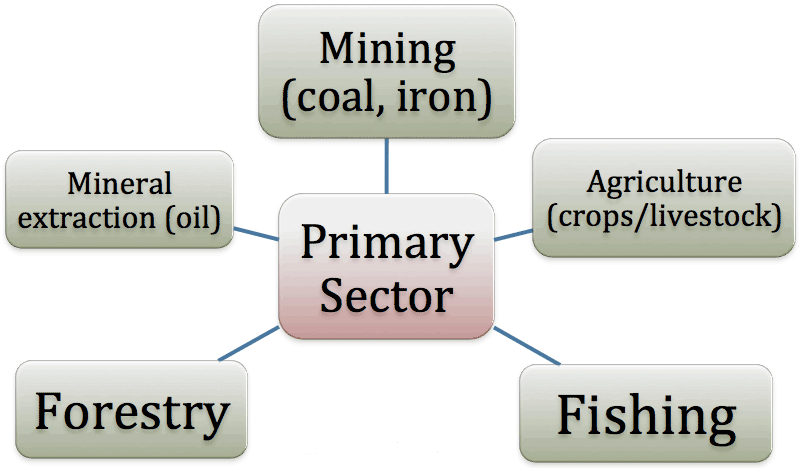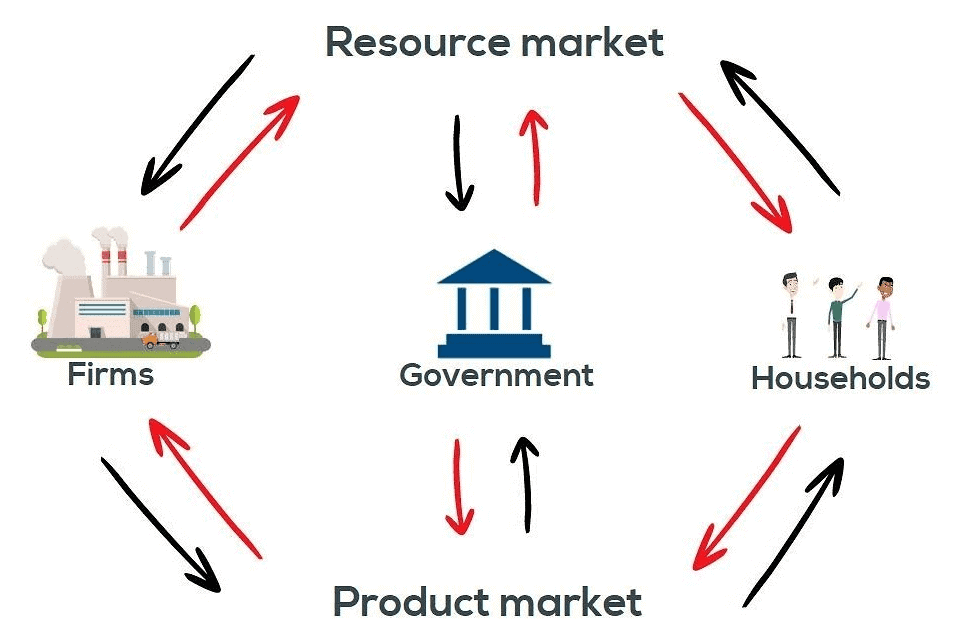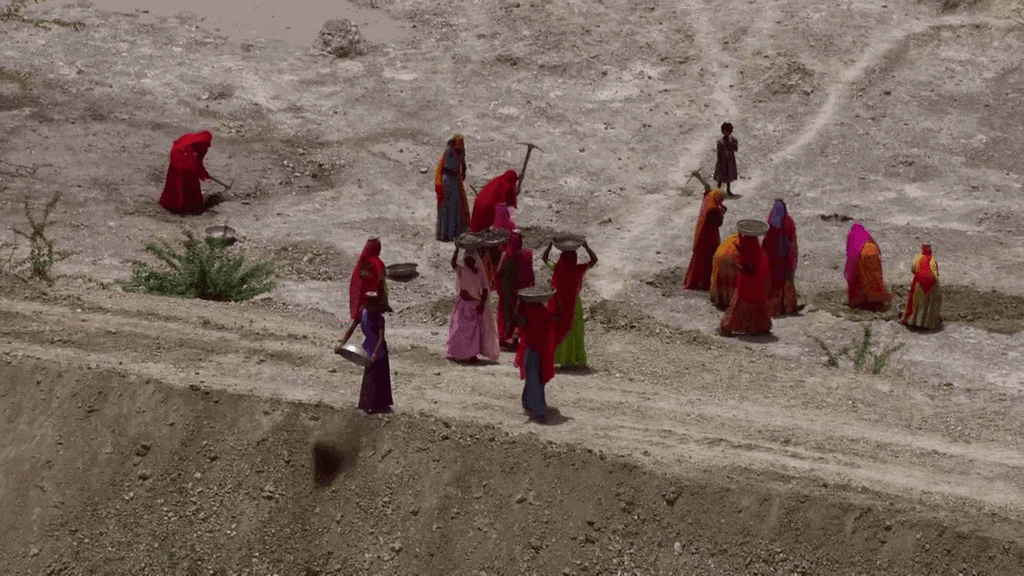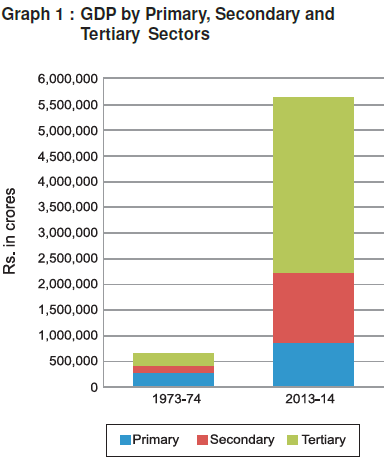All activities that give an income in return are called economic activities.
Example: People going for work in factories, banks, schools, etc.
Economic activities can be classified into different sectors on the basis of the nature of work.
- Goods which are produced by exploiting natural resources come under the category of the primary sector.
- This sector is also called as agriculture and related sector.
Example: Cotton
 Primary Sector of Economy
Primary Sector of Economy
- Transformation of one good into another comes under the category of the secondary sector.
- Manufacturing is one of the important components of this sector.
Example: Transformation of sugarcane into sugar.
- All production units producing services that help in the development of primary and secondary sectors come under the tertiary sector category. This is also known as the service sector.
Example: Services given by doctors, teachers, lawyers etc.
- These three sectors are highly interdependent on one another.
- This can be explained with the help of an example:
- Farmers buy goods such as tractors, pump sets, fertilizers (manufacturing sector) to produce agricultural goods (primary sector).
- This shows the dependence of the primary sector on the secondary sector.
- Now farmers want to sell their output. For this, they need transport facilities. It shows the dependence of the primary sector on the tertiary sector.
 The Dependency of 3 Sectors on Each Other
The Dependency of 3 Sectors on Each Other
- There are thousands of goods and services produced in an economy. We cannot add different types of goods in practice. So the value of these goods and services should be used rather than adding up the actual numbers. Comparison can be done among these three sectors on the basis of the value of final goods and services produced.
- Gross Domestic Product (GDP)The value of final goods and services produced in each sector during a particular year provides the total production of the sector for that year. The sum of production in these sectors gives us the gross domestic product (GDP) of a country.
- Tertiary sector has emerged as the largest sector because it helps in the development of primary and secondary sectors.
- Several services such as hospitals, banks, insurance companies, transport, and educational institutions are the basic services required by primary and secondary sectors for their normal functioning.
- Organized Sector covers those enterprises or places of work where the terms of employment are regular.
- They are registered by the government and have to follow its rules and regulations.
- Therefore people have job security.
- Unorganized Sector covers small and scattered units that are largely outside the control of the government.
- There are rules and regulations, but they are generally not being implemented by the unorganized sector.
- Employment is not secure in the unorganized sector.
In the unorganized sector, protection and support are required for the workers for their economic and social development. Besides getting irregular and low paid work, they also face social discrimination.
- Public sector is the sector that is owned, controlled, and managed by the government. Activities in the government sector are guided by the motive of social welfare and not to earn the profit.
- In the private sector, ownership of production units is in the hands of private individuals. Activities in the private sector are mainly guided by the motive to earn profit.
Example: TISCO and RIL - Employment is an activity from which a person earns the means of living, i.e. income in cash or in kind.
- Unemployment refers to a situation where the persons who are able to work and are willing to work, fail to secure work.
- Underemployment is a situation in which a worker gets work for less time than the time he can work. In other words, he remains unemployed for some months in a year or some hours every day.
- There was a big change in the share of three sectors in G.D.P. (from 1973 to 2000), but data show that such a similar shift has not been taken place in terms of employment.
- In secondary sector output went up by 8 times, but it rose up by only 2.5 times in terms of employment.
- In tertiary sector output went up 11 times whereas employment rose up 3 times.
- Government can create more employment opportunities by providing better:
- Infrastructure such as roads, dams, canals etc.
- Further, this can be enhanced by providing services like banks, transport and communication.
- Set up industries that process vegetables and agricultural products like potatoes, rice, wheat, tomato, fruits which can be sold in outside markets.
- This will provide employment in industries located in semi-rural areas.
Mahatma Gandhi National Rural Employment Guarantee Act-2005 (NREGA -2005)
- This act is implemented as “Right to Work” in all the 604 districts of India.
 Women Employed under NREGA for De-silting a Tank
Women Employed under NREGA for De-silting a Tank - Under this act, all those who are able to work and are in need of work have been guaranteed 100 days of employment in a year by the government. However, only one person per family is entitled to this benefit. Sectors of Economic Activities
- Primary sector/Agricultural sector - use of natural resources - cultivation of cotton
- Secondary sector/industrial sector, manufacturing sector
- Tertiary sector/Service sector
(a) Development of primary and secondary sector
(b) generation of services rather than goods.

Comparing the Three Sectors How do we count the various goods and services and know the total production in each sector
- To include value of final goods and services including the value of all the intermediate goods
- GDP - sum of production of three sectors in a year
- Task of measuring GDP by a ministry with the help of various govt, departments of all States and Union Territories.
 Try yourself:The task of measuring GDP is undertaken by theView Solution
Try yourself:The task of measuring GDP is undertaken by theView SolutionHistorical Changes in Sectors - Initially primary sector
- Changes in agriculture
- Manufacturing and secondary sector
- Change from secondary to the tertiary sector
- Rising importance of tertiary sector - Hospitals, defence, transport, trade, storage, increase in income and new demands, development of IT
- Still more people employed in the primary sector - under-employed/disguised unemployment
- New employment - How to create: Loan by banks, construction of dams for irrigation; transport facilities and storage of crops; to promote local industries; tourism and MGNREGA 2005.
Division of Sectors as Organised and Unorganised Organised - Factory Act, Minimum Wages Act and other facilities.
Unorganised - No such facilities and outside the control of government.
Need to protect workers in the unorganised sector.Sectors in Terms of Ownership: Public and Private Sectors - Public and Private
- Public sector
- Production of electricity
- Railways
- Fair price shops
- Primary responsibility of government
- Private sector i.e., Reliance Industries..



No comments:
Post a Comment